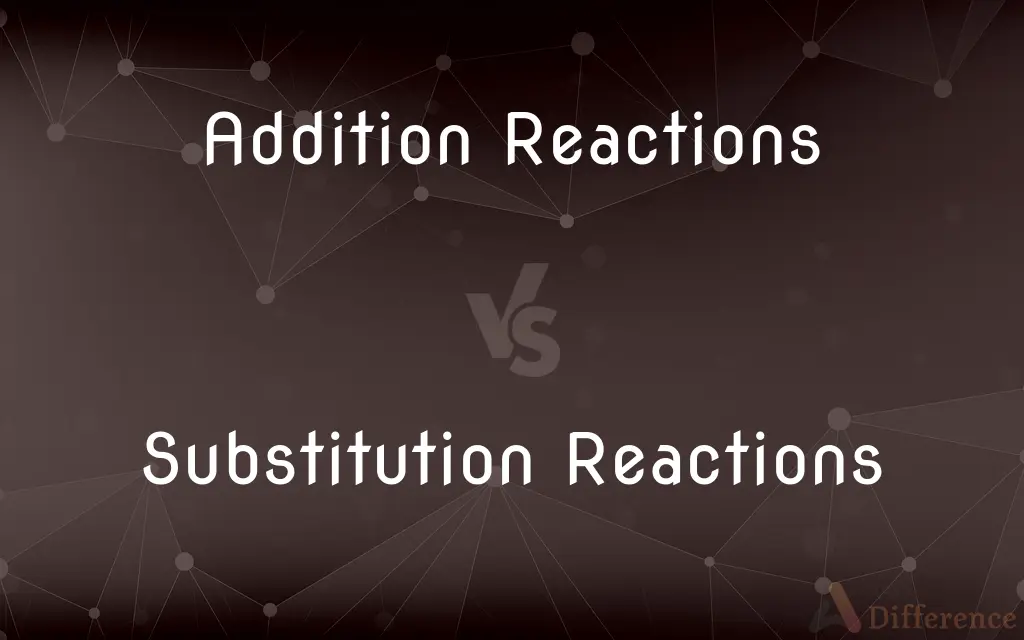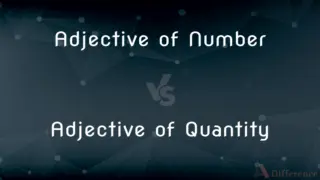Addition Reactions vs. Substitution Reactions — What's the Difference?
Edited by Tayyaba Rehman — By Fiza Rafique — Published on December 29, 2023
Addition Reactions involve adding atoms or groups to a molecule. Substitution Reactions involve replacing one atom/group with another in a molecule.

Difference Between Addition Reactions and Substitution Reactions
Table of Contents
ADVERTISEMENT
Key Differences
Addition Reactions and Substitution Reactions are both vital concepts in the realm of organic chemistry. In Addition Reactions, two reactants combine to form a single product, typically by breaking a pi bond and creating new sigma bonds. Substitution Reactions, on the other hand, entail one atom or group in a molecule being replaced by another atom or group, resulting in a different compound.
Comparing the molecular changes in Addition Reactions and Substitution Reactions offers clear distinctions. During Addition Reactions, the molecule's size generally increases as more atoms or groups are added to it. In Substitution Reactions, the molecule retains its size because the process involves an exchange rather than an addition.
The nature of the starting material can dictate whether Addition Reactions or Substitution Reactions occur. Unsaturated compounds, like alkenes and alkynes, typically undergo Addition Reactions because they contain pi bonds that can be broken to add new groups. In contrast, saturated compounds, such as alkanes, are more prone to Substitution Reactions, especially when exposed to halogens or other electrophiles.
The mechanism and conditions under which Addition Reactions and Substitution Reactions proceed can vary significantly. Addition Reactions can be electrophilic, nucleophilic, or radical-based, depending on the type of initiating species. Substitution Reactions, meanwhile, can either be nucleophilic, with the SN1 and SN2 mechanisms being the most studied, or electrophilic.
One notable consequence of Addition Reactions and Substitution Reactions is their impact on molecular symmetry. Post Addition Reactions, molecules might become more symmetrical as atoms or groups are added uniformly. After Substitution Reactions, however, the molecular symmetry might remain unchanged or even decrease, based on the position and nature of the substituted group.
ADVERTISEMENT
Comparison Chart
Reactants and Products
Two reactants combine to form one product
One atom/group is replaced by another
Molecular Size
Generally increases
Remains unchanged
Starting Material
Unsaturated compounds
Saturated compounds
Mechanisms
Electrophilic, nucleophilic, or radical-based
Nucleophilic (SN1, SN2) or electrophilic
Impact on Molecular Symmetry
Might increase symmetry
Can remain unchanged or decrease symmetry
Compare with Definitions
Addition Reactions
A reaction enlarging a molecule by adding atoms/groups.
The hydrogenation of alkenes is an Addition Reaction, where hydrogen is added to the double bond.
Substitution Reactions
A reaction where one atom/group in a molecule is replaced by another.
The reaction of methane with chlorine is a Substitution Reaction, forming methyl chloride.
Addition Reactions
A transformation mostly involving unsaturated compounds.
Alkenes undergo Addition Reactions when treated with halogens.
Substitution Reactions
A reaction characterized by a swap in molecular components.
Alcohols can undergo Substitution Reactions to form esters with carboxylic acids.
Addition Reactions
A process breaking a pi bond and forming new sigma bonds.
In the hydration of alkynes, an Addition Reaction adds water across the pi bond.
Substitution Reactions
A transformation retaining the molecular size.
In the nitration of benzene, a hydrogen atom is replaced by a nitro group through a Substitution Reaction.
Addition Reactions
A reaction characterized by the increase in molecular components.
Ozone addition to alkenes is an Addition Reaction leading to ozonides.
Substitution Reactions
A process resulting in an exchange of atoms/groups.
Halogenation of alkanes is a classic example of Substitution Reactions.
Addition Reactions
A chemical reaction where two reactants combine to form one product.
The reaction between ethene and bromine is an Addition Reaction, producing 1,2-dibromoethane.
Substitution Reactions
A reaction mainly involving saturated compounds.
Alkanes undergo Substitution Reactions when exposed to UV light and halogens.
Common Curiosities
Why are alkanes mainly involved in Substitution Reactions?
Alkanes are saturated and do not have reactive pi bonds, making substitution more feasible.
Can a compound undergo both Addition and Substitution Reactions?
Yes, it depends on the conditions and the nature of the compound.
Which mechanism, SN1 or SN2, is faster for Substitution Reactions?
It varies based on the substrate, nucleophile, and solvent. SN2 is generally bimolecular and concerted, while SN1 involves a carbocation intermediate.
Are there any stereochemical implications in Substitution Reactions?
Yes, especially in SN2 reactions where inversion of configuration occurs.
Why are Addition Reactions common in polymer synthesis?
Because monomers can add together in a repeating fashion to form long chains.
What is the significance of the leaving group in Substitution Reactions?
A good leaving group facilitates the Substitution Reaction and determines its rate.
What makes alkenes suitable for Addition Reactions?
Alkenes have pi bonds that can break to accommodate added atoms/groups.
Are there any conditions favoring Addition Reactions over Substitution Reactions?
The presence of unsaturated bonds and specific reagents can favor Addition Reactions.
Can aromatic compounds undergo Addition Reactions?
Generally, aromatic compounds prefer Substitution Reactions to retain their aromaticity. However, under certain conditions, they can undergo addition.
What role do catalysts play in Addition Reactions?
Catalysts can speed up Addition Reactions and direct the addition in a specific manner.
Can an Addition Reaction be reversed?
Yes, under specific conditions, the addition product can be reverted to the original compounds.
How does molecular symmetry change post Addition Reactions?
It might increase if atoms/groups are added uniformly.
Why might Substitution Reactions decrease molecular symmetry?
The position and nature of the substituted group can disrupt the existing symmetry.
Are radicals involved in Substitution Reactions?
Radical Substitution is a type where radicals replace atoms/groups in molecules, like halogenation of alkanes.
Can aldehydes and ketones undergo Addition Reactions?
Yes, they can undergo nucleophilic addition at the carbonyl carbon.
Share Your Discovery

Previous Comparison
Adjective of Number vs. Adjective of Quantity
Next Comparison
Navy Seals vs. Delta ForceAuthor Spotlight
Written by
Fiza RafiqueFiza Rafique is a skilled content writer at AskDifference.com, where she meticulously refines and enhances written pieces. Drawing from her vast editorial expertise, Fiza ensures clarity, accuracy, and precision in every article. Passionate about language, she continually seeks to elevate the quality of content for readers worldwide.
Edited by
Tayyaba RehmanTayyaba Rehman is a distinguished writer, currently serving as a primary contributor to askdifference.com. As a researcher in semantics and etymology, Tayyaba's passion for the complexity of languages and their distinctions has found a perfect home on the platform. Tayyaba delves into the intricacies of language, distinguishing between commonly confused words and phrases, thereby providing clarity for readers worldwide.














































